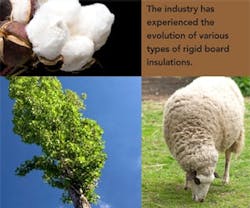New Trends in Insulation
Insulation definitely matters as a key building-system component, but it’s often overlooked as a first-choice, low-cost factor to optimize energy efficiency. As with many building products, new insulation technologies are continuously being developed. In addition to well-established, proven products, like fiber glass and rock and slag wool, the industry has experienced the evolution of various types of rigid board insulations, cellulose, and, more recently, foam insulations, including some that claim to be bio-based. Insulation products also include recycled cotton and sheep’s wool. The recycled content of insulation is also of interest as it relates to LEED.
The North American Insulation Manufacturers Association recently reported that its members’ plants diverted almost 33 billion pounds of recycled materials from the waste stream with the use of glass cullet during 2006 and 2007. Some fiber glass manufacturers also offer unbonded (no binder) blow-in fiber glass, while several members offer alternative binders for batt insulation.
Research has spawned the introduction of new insulation technologies, such as nano materials. Georgia Tech is investigating the development of composite materials from chicken feathers for application in buildings, including acoustic ceiling tiles, moisture-resistant drywall, and insulation. One type of green insulation that you won’t find in the United States yet is called “industrial hemp,” which is a type of low-narcotic hemp. Hemp insulation comes from a renewable resource and is biodegradable; it’s also breathable. It has first-rate sound absorption and deters mold and bugs. It’s also stiffer than many other fiber insulations and doesn’t slump after it’s installed. There are some limitations on where hemp can be used (it’s not suitable for cavity wall insulation, for example).
New technologies in insulation are certainly worth investigation, but authors J. David Odom, Richard Scott, and George H. DuBose, in their NCARB paper, The Hidden Risks of Green Buildings: Avoiding Moisture & Mold Problems, tell us that the use of many new building products often has the unintended consequence of performing in unexpected ways – sometimes encouraging significant moisture accumulation and mold growth by masking sources of sustaining moisture. This may require a more rigorous evaluation of these materials than is required with traditional products.
Stewart Brand’s caution in How Buildings Learn: What Happens After They’re Built echoes what forensic building consultants and building scientists have seen for decades – anything that departs from the “tried-and-true method” often fails.
Beyond insulation types, it’s also critical to understand other technologies, such as:
- ICFs (insulating concrete forms).
- Insulated metal panels.
- Concrete structural insulated panel wall systems constructed with foam and concrete.
- SIPs (structural insulated panels) that include foam, rigid board, and fiber glass insulations.
- 2x6 advanced framing.
- Super-insulated system approaches to envelope design.
Fiber glass high-performance batts are higher density and have higher insulating ability than standard fiber glass batts, ideal for super-insulated sidewalls where insulation levels of R-21 are recommended. Thermal performance isn’t the only benefit in specifying insulation products like fiber glass and rock and slag wool – they also provide superior fire protection and contribute to STC acoustic noise control in wall cavities, ceilings, floors, and ductwork. Fire safety in insulation materials varies and should be thoroughly researched.
Paul R. Bertram Jr. is the director of environment and sustainability at the Alexandria, VA-based North American Insulation Manufacturers Association.
